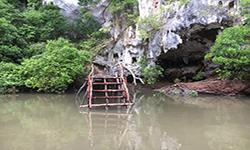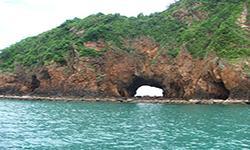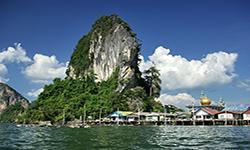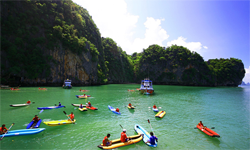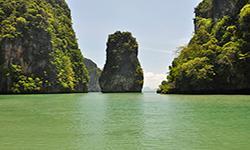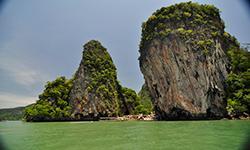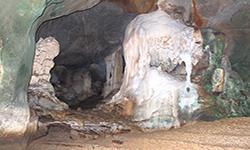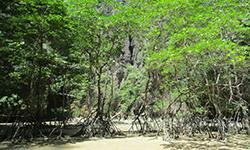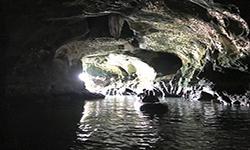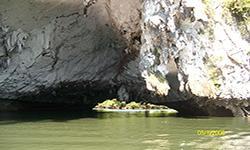Ao Phang-Nga National Park
Contact Location : Ao Phang-Nga National Park, 80 Moo 1 Ban Tha Dan, Ko Panyi Sub-district, Mueang Phang-Nga District, Phang-Nga Province 82000
Telephone Number : (+66) 7 648 1188, (+66) 7 648 1163 Fax:(+66) 7 648 1188
Email : aophangnga_np@hotmail.com
Facebook : Ao Phang-Nga National Park
Information
Ao Phang-Nga National Park is located on the coast of the Andaman Sea in Thailand and covers Krasom, Kalai and Khlong Khian Sub-district, Takua Thung District, Ko Pan Yi Sub-districtin , Mueang Phang-Nga District, Ko Yao Noi and Ko Yao Yai Sub-district, Ko Yao District, in Phang-Nga Province. The coordinates are between the latitude 080 04/ – 080 24/ north and the longitude 980 04/ - 980 – 36/ east. The area is approximately 400 square kilometers, or about 250,000 rai, with contiguous territories as follows:
North: Mangrove Swamp Forest in the area of Muang Phang-Nga District, Phang-Nga Province
South: Ko Yao District, Phang-Nga Province and the Sea Region of Phuket Province.
East: the area of Krabi Province
West: The area of mangrove swamp forest and the seashore of Takua Thung and Mueang District, Phang-Nga Province.
Background
-
Note : After paying the entrance fee to the National Park, please carry the receipt for inspection.
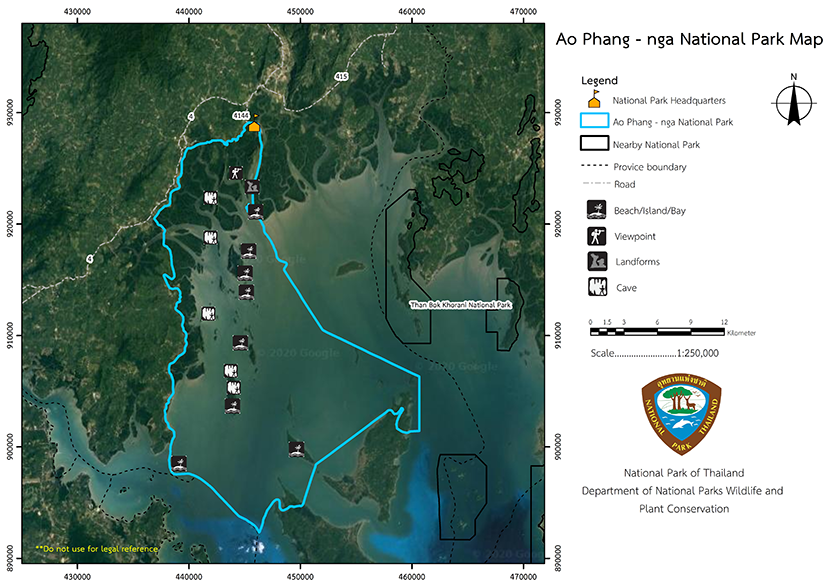
250,000 rai (400 square kilometers)
|
|
|
|
|
|
|
|
|
|
|
|
|
|
|
|
|
|
|
|
|
|
|
|
Nature trails ⇔ Cave exploration/Geological condition ⇔ Observe flowers/plant ⇔ History/Culture ⇔ Bird/Butterfly ⇔ Wildlife watching activities ⇔ Take a boat ride or a paddle
Welfare shop : (Restaurant) : Open every day from 09.00 - 19.00 hrs.
National Park Headquarters: TRUE, DTAC
Khao Phing Kan-Khao Ta Pu area: AIS
Ko Talu area: AIS
Ko Pan Yi area: AIS
Ko Hong - Ko Phanak: AIS
Ko Lawa Yai area: AIS, TRUE, DTAC
|
|
The north is adjacent to a mangrove swamp forest in Mueang Phang Nga District. The south meets the sea of Ko Yao in Phang Nga and Phuket Province. The east is next to the sea of Krabi Province. The west is adjacent to a mangrove swamp forest in Takua Thung and mueang district, Phang Nga Province. is dominated by sedimentary rock mountains alternating with long lines of metamorphic rock. Limestone mountains are widely distributed and are home to natural features such as cavities, caves, and land collapses, as in the west, causing it a rough coastal area, appearing bays and islands, with beautiful scenery. Ao Phang-nga National Park Influenced by the southwest monsoon, temperatures average 26–28 degrees Celsius, with an average annual rainfall of about 3,500 mm.
|
|
The climate characteristics of Ao Phang-Nga National Park depend on the southwest monsoon and the northeast monsoon. The southwest monsoon season causes heavy rain from May until October, and then from November until March or April there is a constant northeast wind. Typically, Ao Phang-nga has excellent visibility, except during the rainy season. While moderate to rough seas occur during the southwest monsoon, calm waves happen during the northeast monsoon, except in November, the wave is mild-moderate, sometimes heavy-very heavy.
|
|
|
|
Plant species in Ao Phang-Nga National Park have different topography, soil features, sea currents, and human activities that interfere with natural conditions, and as a result are classified into five types: 1.Mangrove Swamp Forest 1.1 Mangrove Swamp Forest in Limestone Mountain contains up to 12 species in the forest, including Loop-Root Mangroves, Small-Leaved Mangroves, Xylocarpus granatum J.Koenig, Xylocarpus moluccensis (Lam.) M.Roem., Bruguiera gymnorrhiza (L.) Savigny, Navy Bean, Bruguiera parviflora (Roxb.) Wight & Arn. ex Griff., Ceriops, Bruguiera sexangula Poir., Sonneratia caseolaris (L.) Engl., Sonneratia alba Sm., Kandelia candel (L.) Druce, and Avicennia alba Blume. On the muddy soil or along the waterfront, visitors will find palm trees and sea holly shrubs. Sea cycads are rarely seen as they reside in areas where forests have been destroyed. 1.2 Mangrove swamp forests in the Shell and Quartzite mountains have seven important plant species that include Large-Leaved Mangroves, Small-Leaved Mangroves, Xylocarpus granatum J.Koenig, Bruguiera gymnorrhiza (L.) Savigny, Navy Bean, Bruguiera parviflora (Roxb.) Wight & Arn. ex Griff., and Ceriops. The ground plants include Sea Holly Shrubs, Summana, and Wai Tamoi, which grow densely along the waterfront. 1.3 Mangrove swamp forests on the sandstone mountains are home to few plant species due to the sandy soil, wind, tides, and salt. Five essential plant species are found which include Large-Leaved Mangroves, Small-Leaved Mangroves, Sonneratia alba Sm., Avicennia alba Bl, Xylocarpus granatum J.Koenig, and Syzygium lineatum. Samet trees (Melaleuca leucadendra (L.) L.) are often in the area adjacent to the terrestrial forest where the water has a relatively low salinity. 2.The terrestrial forest is a tropical rain forest, which is classified as follows: 2.1 The forest on limestone mountains has 2 types in Ao Phang-Nga, which are - The forest grows in a relatively humid area of limestone mountain, which has short and small trees, apart from those that have found nutrient-rich rock niche. Plants found include Malabar Iron Wood, Phalaenopsis cornu-cervi (Breda) Blume & Rchb. f., Cashew Nut Olive, and Lagerstroemia floribunda Jack. 2.2 The forest in Shell and Quartzsite mountains is dense with plant species. Approximately 70-90% of the canopy is Dipterocarpus alatus, with lower levels home to other important plants such as Needle Wood, Bruguiera gymnorrhiza (L.), andAcacia mangium Willd. The ground plants found include wild bamboo and Trema orientalis. 3. The most common aquatic plants in Ao Phang-Nga National Park is algae, which appears in mangrove swamp forest or along the beach. Algae is divided into three types; Brown Algae, Green Algae, and Red Algae. Other marine organisms are seagrasses and plankton, which are the vital food sources for various aquatic animals. The rarest plant species in Ao Phang-Nga National Park is the Yellow Phang-Nga Venus Slipper Orchid, which grows on cliffs, in crevices, or on high limestone rocks at 100 meters above sea level. It has a single flower with an upright stalk and a short hair covering. The flower is 5 – 8 centimetre in diameter at full bloom, with a soft white bulb. It blooms between April and August and from November until December. Animals in Ao Phang-Nga National Park can be divided into the following categories: 1. Mammals: 27 species, which include the Crab-Eating Macaque, Dusky Leaf Monkey, Grey-Bellied Squirrel, Chamois, Berdmore's Ground Squirrel, Smooth-Coated Otter, Moonrat, Common Treeshrew, Long-Tailed Pangolins, Black Rat, Mus, and Otters. 2. Birds: There are 120 species including the Striated Heron, Brahminy Kite, White-Bellied Sea eagle, Malaysian Plover, Pink-Necked Green Pigeon, Green-Billed Malkoha, Edible-Nest Swiftlet, Common Kingfisher, Mangrove Whistler, and Dark-throated Oriole. 3. Reptiles: There are 26 species including the Amboina Box Turtle, Asian Leaf Turtle, Black Marsh Turtle, Gecko, Orange-Winged Flying Lizard, Forest-Crested Lizard, Butterfly Lizard, Monitor Lizard, Many-Striped Skink, Olive Tree Skink, Radiated Rat Snake, Banded Krait, Oriental Wolf Snake, Dog-Faced Water Snake, Speckle-Bellied Keelback, and Red-Necked Keelback 4. Amphibians: There are 4 species which include the Mangrove Frog, Grass Frog, Hoplobatrachus rugulosus, and Polypedates leucomystax. 5. Fish found includeSharks, Stingrays, Eels, Pomfret, Longtooth Grouper, Mullet, Sea Bass, Mudskippers, Catfish, Butterflyfish, and Rastrelliger Fish. |
How to get there by car :
visitors can drive one two routes : From Bangkok, take Highway No. 4, pass to Phang-Nga Province which is a distance of 788 kilometers, taking around 12 hours. In Chumphon, take Highway No. 41,into Surat Thani Province, where you should turn right onto Highway No. 401 until you reach the Ban Ta Khun District, Surat Thani Province. Take Highway No. 415 to Thap Put district in Phang-Nga town
How to get there by train:
The State Railway of Thailand travels from Bangkok to Phun Phin Station, Surat Thani Province. Then take a bus to Phang-Nga Province, which takes about 2 hours. For more information, contact the State Railway of Thailand on Tel. 1690, (+66) 02-223 7010, 02-223 7020 or www.railway.co.th.-
How to get there by bus :
The Transport Company Limited offers air-conditioned and regular buses from Bangkok to Phang-Nga daily, departing from the Southern Bus Terminal on Borommaratchachonnani Road. Travel time takes about 10 hours.
For more information, call (+66) 2 894 6122.
Book tickets, call (+66) 2 422 4444, or visit www.transport.co.th
Phang-Nga Station at Phetkasem Road (behind the Royal Thai Bank), Tel. (+66) 0 7641 2300, 0 7641 2014
From Phang-Nga Province, there are buses to various destinations, such as Phuket, Krabi, Trang, Phatthalung, Hat Yai, Songkhla, Pattani, Narathiwat, Su-Ngai - Klok, Ban Ta Khun and Phunphin District, in Surat Thani Province. There is a shuttle bus from the market to the customs pier, where tourists can rent a boat to Ao Phang-Nga National Park
How to get there by planes:
Visitors can fly to Phuket and then take a bus to Phang-Nga Province from Phuket International Airport, which is a distance of about 58 kilometers. From Ranong Airport, you can also take a bus to Phang-Nga City, which takes approximately 3 hours. For more information, contact Ao Phang-Nga National Park at tel. 076 481 188 or e-mail aophangnga_np@hotmail.com
Update soon
- National Park Ranger Station O Pho No. 1 (Ko Lawa Yai)
- National Park Ranger Station O Pho No. 2 (Khao Phing Kan)
- National Park Ranger Station O Pho No. 3 (Ko Boi Yai)
- National Park Sub Ranger Station O Pho (Ko Hong)
Accommodation : Ao Phang-Nga 102/1-4 (Khao Phing Kan)
Ao Phang-Nga National Park offers food service, accommodation, a camping ground, a tent, and equipment rental service.

